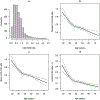Asymptotic Properties for Cumulative Probability Models for Continuous Outcomes
- PMID: 38374966
- PMCID: PMC10875740
- DOI: 10.3390/math11244896
Asymptotic Properties for Cumulative Probability Models for Continuous Outcomes
Abstract
Regression models for continuous outcomes frequently require a transformation of the outcome, which is often specified a priori or estimated from a parametric family. Cumulative probability models (CPMs) nonparametrically estimate the transformation by treating the continuous outcome as if it is ordered categorically. They thus represent a flexible analysis approach for continuous outcomes. However, it is difficult to establish asymptotic properties for CPMs due to the potentially unbounded range of the transformation. Here we show asymptotic properties for CPMs when applied to slightly modified data where bounds, one lower and one upper, are chosen and the outcomes outside the bounds are set as two ordinal categories. We prove the uniform consistency of the estimated regression coefficients and of the estimated transformation function between the bounds. We also describe their joint asymptotic distribution, and show that the estimated regression coefficients attain the semiparametric efficiency bound. We show with simulations that results from this approach and those from using the CPM on the original data are very similar when a small fraction of the data are modified. We reanalyze a dataset of HIV-positive patients with CPMs to illustrate and compare the approaches.
Keywords: 62G99; asymptotic distribution; cumulative probability model; semiparametric transformation model; uniform consistency.
Conflict of interest statement
Conflicts of Interest: The authors declare no conflict of interest.
Figures





Similar articles
-
Addressing Multiple Detection Limits with Semiparametric Cumulative Probability Models.J Am Stat Assoc. 2024;119(546):864-874. doi: 10.1080/01621459.2024.2315667. Epub 2024 Apr 1. J Am Stat Assoc. 2024. PMID: 39463921 Free PMC article.
-
An empirical comparison of two novel transformation models.Stat Med. 2020 Feb 28;39(5):562-576. doi: 10.1002/sim.8425. Epub 2019 Dec 6. Stat Med. 2020. PMID: 31808976 Free PMC article.
-
Modeling continuous response variables using ordinal regression.Stat Med. 2017 Nov 30;36(27):4316-4335. doi: 10.1002/sim.7433. Epub 2017 Sep 5. Stat Med. 2017. PMID: 28872693 Free PMC article.
-
Semiparametric Analysis of Heterogeneous Data Using Varying-Scale Generalized Linear Models.J Am Stat Assoc. 2008;103(482):650-660. doi: 10.1198/016214508000000210. J Am Stat Assoc. 2008. PMID: 19444331 Free PMC article.
-
Tufts PACE Clinical Predictive Model Registry: update 1990 through 2015.Diagn Progn Res. 2017 Dec 21;1:20. doi: 10.1186/s41512-017-0021-2. eCollection 2017. Diagn Progn Res. 2017. PMID: 31093549 Free PMC article. Review.
Cited by
-
Analyzing clustered continuous response variables with ordinal regression models.Biometrics. 2023 Dec;79(4):3764-3777. doi: 10.1111/biom.13904. Epub 2023 Jul 17. Biometrics. 2023. PMID: 37459181 Free PMC article.
-
Addressing Multiple Detection Limits with Semiparametric Cumulative Probability Models.J Am Stat Assoc. 2024;119(546):864-874. doi: 10.1080/01621459.2024.2315667. Epub 2024 Apr 1. J Am Stat Assoc. 2024. PMID: 39463921 Free PMC article.
References
-
- Box GEP; Cox DR An analysis of transformations (with Discussion). J. R. Stat. Soc. Ser. B 1964, 26, 211–252.
-
- Doksum KA An extension of partial likelihood methods for proportional hazard models to general transformation models. Ann. Statist 1987, 15, 325–345.
-
- Cuzick J Rank regression. Ann. Statist 1988, 16, 1369–1389.
-
- Pettitt AN Inference for the linear model using a likelihood based on ranks. J. R. Statist. Soc. Ser. B 1982, 44, 234–243.
-
- Kalbfleisch JD; Prentice RL Marginal likelihoods based on Cox’s regression and life model. Biometrika 1973, 60, 267–278.
Grants and funding
LinkOut - more resources
Full Text Sources
